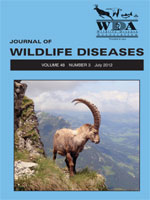Hematologic and serum biochemical data collected must be interpreted by comparison with normal reference intervals generated from healthy animals, within a similar population, because many blood parameters are influenced by diet, environment, and stress. Species-specific reference intervals for the endangered island fox (Urocyon littoralis) are not available. We reviewed hematology and serum biochemistry panels from 280 island foxes sampled from 1999–2008 and established normal reference intervals from clinically healthy foxes using a nonparametric approach. Blood parameters were analyzed for differences in age, sex, island of origin, and captivity status. Alkaline phosphatase, alanine aminotransferase, aspartate aminotransferase, and creatine kinase activities, as well as calcium and phosphorus concentrations, were significantly higher in juveniles than in adults, but total protein and globulin concentration was lower for juveniles than for adults. Lymphocyte and eosinophil counts, and blood urea nitrogen (BUN) concentration, in foxes from the northern Channel islands of California, USA (Santa Cruz, Santa Rosa, and San Miguel) were higher when compared with foxes from Santa Catalina Island to the south. Higher lymphocyte and eosinophil numbers in the northern island foxes may be associated with increased levels of parasitism on the northern islands. Differences in BUN concentration in both free-ranging and captive foxes may reflect dietary differences among islands. Although aggressive conservation programs have been enacted, island foxes are still susceptible to infectious and neoplastic diseases and, potentially, to toxins. Island fox species-specific reference intervals will enable managers and veterinarians to better care for sick and injured foxes and will contribute to future population health monitoring.
How to translate text using browser tools
1 July 2012
BIOCHEMICAL AND HEMATOLOGIC REFERENCE INTERVALS FOR THE ENDANGERED ISLAND FOX (UROCYON LITTORALIS)
Hiromi Inoue,
Deana L. Clifford,
T. Winston Vickers,
Timothy J. Coonan,
David K. Garcelon,
Dori L. Borjesson
ACCESS THE FULL ARTICLE

Journal of Wildlife Diseases
Vol. 48 • No. 3
July 2012
Vol. 48 • No. 3
July 2012
biochemistry
hematology
Island fox
reference intervals
Urocyon littoralis




